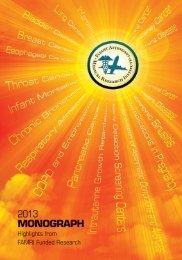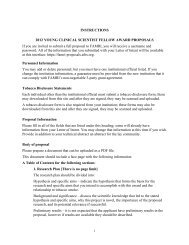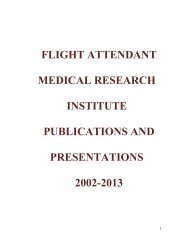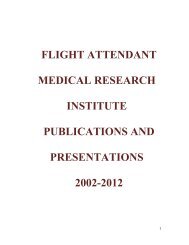MISSION
2009 compendium of FAMRI-supported research - Flight Attendant ...
2009 compendium of FAMRI-supported research - Flight Attendant ...
You also want an ePaper? Increase the reach of your titles
YUMPU automatically turns print PDFs into web optimized ePapers that Google loves.
utilize telephone conference call focus groups were implemented that has allowed successful recruitment of<br />
parent smokers. The project has completed several focus groups. With the success of this mode of focus<br />
group recruitment, the PI intends to use this format to interview a wider sample of subjects in other<br />
geographic locations without travel or time expenses usually associated with using other sites. A revision<br />
was submitted to their IRB to expand their recruitment to include print newspaper advertisements outside<br />
of existing clinical catchment area. To date, 16 former smoking women have been interviewed. Using their<br />
new modality, a greater variety of subjects will be attracted. This project is also designed to become an<br />
integral component of the Dissemination of Best Practices initiative. Message testing with existing CEASE<br />
materials will begin shortly with early focus group participants, as the phone script for live messages are<br />
developed and responses are captured. For the greatest convenience of their participants, selections of<br />
messages will be presented in a mailed packet, and have the packet opened during the phone interview<br />
using a protocol that has been successful in obesity messaging research. In addition, the pilot practices will<br />
be recruited, and the practitioners similarly invited to respond to the messages as they are developed.<br />
FAMRI-IELCAP COLLABORATIVE NETWORK, 2007<br />
Director: Claudia I. Henschke, PhD, MD<br />
The FAMRI-IELCAP Collaborative Network is a multi-disciplinary research and clinical program to<br />
enhance early detection and treatment of lung, cardiovascular, and sinus diseases related to SHS exposure.<br />
The approach encompasses a wide range of disciplines ranging from the use of CT for early detection of<br />
these diseases combined with advanced imaging processing, to laboratory development of key biomarkers.<br />
FAMRI Supported Publications<br />
Lane ME, Yankelevitz DF, Henschke CI, Vazquez MF, Xiang Z, Kimmel M, Kramer A, Wadler S.<br />
Hierarchical cluster analysis of pulmonary fine needle aspirates reveals distinct subgroups of adenocarcinomas<br />
Presented at the 12th International Conference on Screening for Lung Cancer. Nara, Japan, April<br />
2005.<br />
Lane WE, Yankelevitz DF, Henschke CI, Vazquez MF, Xiang Z, Kimmel M, Kramer A, Wadler S. Patterns<br />
of gene expression in pulmonary fine needle aspirates (FNA) with diverse radiographic appearances<br />
Presented at the 11th International Conference on Screening for Lung Cancer. Rome, Italy, October<br />
2005.<br />
Lane ME, Yankelevitz DF, Henschke CI, Vazquez MF, Xiang Z, Kimmel M, Kramer A, Wadler S.<br />
Pulmonary fine needle aspirates (FNA) with diverse radiographic appearances exhibit distinct patterns of<br />
gene expression. Proc Amer Assoc Cancer Res #876 2005.<br />
Lane ME, Yankelevitz DF, Henschke CI, Vazquez MF, Xiang Z, Kimmel M, Kramer A, Wadler S. Patterns<br />
of gene expression in pulmonary fine needle aspirates (FNA) with diverse radiographic appearances<br />
exhibit distinct patterns of gene expression. Proc Amer Assoc Cancer Res 2004 45:5589.<br />
URINARY PGE-M: A NONINVASIVE BIOMARKER OF TOBACCO SMOKE-INDUCED PULMONARY INJURY<br />
Andrew Dannenberg, MD<br />
COPD is one of the leading causes of disability and death worldwide. Unfortunately, tobacco smokeinduced<br />
lung disease, including COPD, is frequently not recognized until severe damage has occurred.<br />
The goal is to develop a simple, noninvasive urinary test of pulmonary inflammation for individuals or<br />
populations exposed to tobacco smoke, including SHS. This approach may facilitate the early detection of<br />
disease and provide the foundation for pharmacological and behavioral strategies that alter the natural<br />
history of tobacco smoke-induced disease. The first specific aims of this project is to compare levels of an<br />
inflammatory biomarker in the urine among groups of individuals that vary in smoke exposure. Levels of<br />
the urinary metabolite will be correlated with severity of pulmonary disease as assessed by spiral computer<br />
tomography and pulmonary function tests. The second specific aim is to evaluate the effect of smoking<br />
reduction and/or cessation on levels of the urinary biomarker of inflammation. The PI hypothesizes that<br />
levels of the urinary marker will decrease in current smokers as they reduce and/or quit smoking and that<br />
it may be useful for personalized risk assessments, to increase motivation among smokers contemplating<br />
quitting and to reinforce the health benefits of reducing tobacco smoke exposure. The third specific aim is<br />
to determine whether the magnitude of elevation of the urinary biomarker of inflammation varies by<br />
genetic polymorphism status for a given level of tobacco smoke exposure. This information may provide<br />
new insights into the link between tobacco smoke, host susceptibility, and pulmonary inflammation.<br />
During the past year, an opportunity presented itself to evaluate the effects of SHS on levels of an<br />
4 6 P A G E







